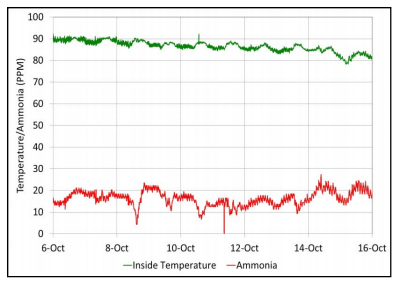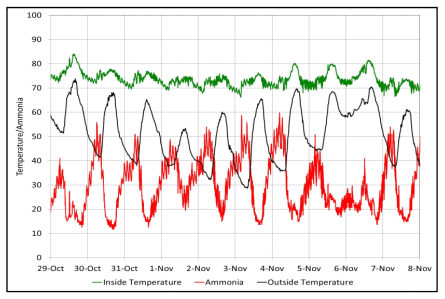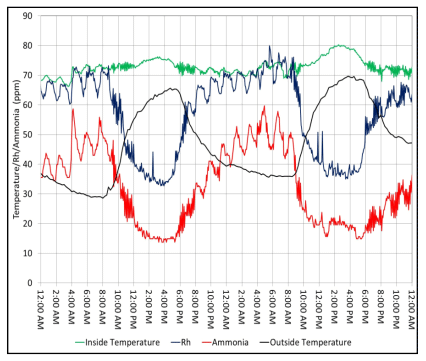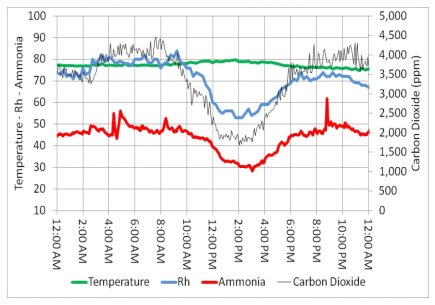The growing importance of nighttime air quality
Published: October 28, 2015
By: Mike Czarick
During cool weather, maintaining good air quality is vital to avoid bird health issues. It is a 24- hour-a-day, seven-day-a-week, job. One of the most important air quality variables that must be kept to a minimum is ammonia. High ammonia levels can paralyze and/or damage a bird’s tracheal cilia, which are a vital tool a bird uses to fight off disease. The cilia are microscopic finger-like projections that cover a bird’s trachea. A thin layer of sticky mucus covers the cilia which can trap pathogens traveling on small particles in the air. The cilia move in a wavelike pattern pushing the pathogen-carrying mucus up to the birds’ mouths where they then swallow it and the pathogens are killed off by digestive acids. But, if the cilia are paralyzed and/or damaged by high ammonia levels the pathogens can then travel through the stationary mucus layer down to the tracheal base cells where they start multiplying causing the birds to get sick (i.e. bronchitis). Worse yet, the pathogens can kill off the cilia cells which makes it easy for a wide variety of other pathogens to be introduced into the bird, leading to secondary infections (i.e. E. coli). Though long periods of high ammonia are of greatest concern, it is important to realize that research has shown that acute spikes in ammonia are potentially more damaging than constant low levels of ammonia. This is why producers have to make sure that ammonia levels are kept to a minimum not only during the day, but at night as well.
During the cooler times of the year air quality during brooding tends to be fairly consistent over the course of the day. This is because air exchange rates are determined by minimum ventilation fan timer settings which most producers leave the same 24 hours a day. Furthermore, since the young birds are not producing a significant amount of heat and outside temperatures are well below target temperatures the house never goes into “cooling” mode where ventilation rates would increase. As a result, if the ammonia levels are low in the afternoon it is typically safe to assume that they would be low in the middle of the night (Figure 1). Unfortunately, the same cannot be said for later on in the flock.
With older birds, the amount of fresh air that is brought into the house during cold weather is not solely determined by minimum ventilation fan timer settings like it is during brooding. The older the birds get, the greater the amount of heat they produce, the lower the house set temperatures, the more likely fans will operate during the day as outside temperatures become closer to inside temperatures in order to maintain the proper house temperature. As a result, daytime ventilation rates can often be two to three times as high as they are at night. Since ventilation rates tend to be higher during the day than at night, air quality can be significantly better during the day than at night (Figure 2).
Diurnal variations in air quality in poultry houses can prove problematic for poultry house managers. For the most part, air quality is evaluated during the daylight hours when the birds are being tended to. If the ammonia levels appear acceptable, ventilation rates are typically not changed. Herein lies the problem. Just because ammonia levels are acceptable during the day doesn’t necessarily mean that there aren’t potentially harmful levels at night. It is important to keep in mind that ammonia concentrations in a poultry house are generally proportional to ventilation rates. As a result, if ventilation rates are reduced by 50% at night because the minimum ventilation fans are only operating off of interval timers and not temperature, the ammonia concentrations will be twice as high at night then they were during the day. If the fans are only operating a third as much at night, ammonia concentrations can be three times as high at night then they were during the day (Figure 3).
The fact that air quality can vary dramatically from day to night can lead to unexplained bird health issues. It’s a frustrating situation. House temperatures are correct, ammonia levels are less than 20 PPM, the relative humidity and dust concentrations are low; everything appears ideal, but mortality is climbing and the birds are starting to show signs of the onset of respiratory disease. Why are the birds becoming ill?
It is important to realize that there is always some type of disease challenge present in a poultry house. Twenty four hours a day, seven days a week, 52 weeks a year, the birds are constantly being challenged. It’s not that different from the respiratory disease challenges (i.e., colds and the flu) we face during cold weather. Most of the time the bird’s immune system can deal with the challenge. But, the magnitude of the challenge tends to increase during cold weather because the concentration of any pathogen that may be present in the house increase as ventilation rates decrease (for us as well as we spend more time indoors). At night the situation can become critical as outside temperatures drop and the air exchange rates decrease to their lowest levels while pathogen concentrations and ammonia concentrations are at their highest. The combination of increased pathogen and high ammonia concentrations tend to suppress a bird’s immune system. When this occurs for eight hours a night for multiple nights in a row, that is often all it takes for a respiratory disease to take hold.
So how do we know if we are ventilating enough at night to control ammonia? Ideally ammonia concentrations, like house temperatures, would be monitored 24 hours a day, but this is simply not practical. An accurate ammonia meter like the one used to produce the graphs in this newsletter costs approximately $10,000 and costs thousands of dollars a year to maintain. A second option of course would be to get up every night and check the birds at 3 am...again, not very practical. The fact is we can get a pretty good idea of what is happening at night by simply monitoring house humidity levels. Though relative humidity is primarily a measure of house moisture levels it is also an indicator of other important air quality variables such as ammonia and carbon dioxide. A high relative humidity is typically an indicator of low air exchange rates and as a result ammonia and carbon dioxide levels will also tend to be high. If there are wide variations in relative humidity levels from day to night then there are very likely wide variations in ammonia concentrations. Furthermore, if the relative humidity at night is 70 %+ on a regular basis, chances are ammonia levels are becoming excessive at night (Figure 4).
One of the best ways to monitor relative humidity is through a house’s environmental controller. A modern controller can continuously monitor relative humidity and keep a record of how high the relative humidity is each night. Some controllers will even increase minimum ventilation fan runtime a set amount if relative humidity climbs above a set level which can prove extremely helpful for making sure proper conditions are maintained in the middle of the night. Another option would be to use a temperature/relative humidity data logger. Some temperature/Rh loggers are cable of recording temperature and relative humidity every five minutes for an entire flock (30 days using a one-minute sample rate) and unlike many other data loggers, displays the current readings. High/low relative humidity limits can be set and if reached they can be displayed and reset with a simple push of a button on the top of the logger.
A relative humidity sensor for an environmental controller or accurate temperature data logger will typically cost between $200 and $300. Though this may seem excessive, the information they can provide about air quality in poultry houses in the middle of the night is incredibly valuable. In the end we can do a great job of providing the ideal environment for our birds during the day but if our birds become sick because we are ignorant of what is happening in our houses at night, the cost can easily climb into the thousands of dollars for both the poultry producer and the poultry company.
Figure 1. Broiler house air temperature and ammonia concentrations (Day 1 - 10)

Figure 2. Inside/outside temperature and ammonia for a house with three-week-old birds.

Figure 3. Inside/outside temperature, ammonia, and relative humidity for a house with three-week-old birds (November 3 - 4).

Figure 4. Temperature, relative humidity, carbon dioxide and ammonia levels in a house with 21 day old birds.

Related topics:
Authors:
University of Georgia
Recommend
Comment
Share
University of Georgia
4 de enero de 2016
Ing. Dragan Ionut:
Why should a ventilation rate be based on bird weight?
Mike Czarick
Recommend
Reply
University of Georgia
16 de noviembre de 2015
Gobinath
If you are looking to add something to the litter to reduce ammonia generation the product you need would ideal change the ph of the litter to more acidic. There are products like PLT or Alum which are widely used in the U.S.
Recommend
Reply
University of Georgia
12 de noviembre de 2015
Hello Amresh:
It is important to keep in mind that o2 is not an issue in poultry houses unless birds are grown at high altitudes. We need to primarily concentrate on moisture. If we keep moisture under control we can tend to keep ammonia under control. CO2 can issue during brooding.
I am not sure how keeping off Fed control nh3
Having a dark period at night has shown to be helpful.
Take care
Mike Czarick
Recommend
Reply
11 de enero de 2016
Mortality Effected due to low temperature at night time.
Hi there,
I have poultry of 7000 chick but the rapid death(30-40 per day) rate is make a big issue for me.
i have a farm of 300 m but temperature is not maintain.I do lot for this but not able to got my target (Eg : 35'C).
please suggest me particular method to maintain temperature at winter night
eg:2 - 3'C out side temperature.
If any suggestion pls mail me ( vineet4458@gmail.com )
Please Help its matter for me a lot.
Recommend
Reply
6 de enero de 2016
Poultry Management is the Basic Role in Success full Farming.Manage Best Way & Enjoy Ever ??.
Dr Ghulam Ali Jafri
DVM,RVMP,MD Technical
Five Star Proteins & Meridian Enterprises
Sialkot Pakistan.
drghulamalijafri@gmail.com
Recommend
Reply
6 de enero de 2016
Dear Dr Mike.
This answer is a generally answer . Because you already study this situation ( I mean minimum ventilation and ammonia concentration in poultry houses- I read some of your articles on internet ) I am glad if you want to share your experiences with us .
What is your opinion about minimum ventilation ( if we will exclude the humidity correction ) . I want to know your opinion about minimum ventilation at 55-60 % RH and without co2 and nh3 sensors
Thank you
Recommend
Reply
5 de enero de 2016
Dear Dr Mike
In order to have a proper ventilation you must know at least a minimum ventilation . Usualy , for broiler we use 0.7 cubic meter per kg live weight. I do not know how is the weather in Georgia but in Romania in winter we have usualy -20 degree celsius . We must know how much is the minimum ventilation for a minimum gas consumption. And we have a formula....
And - a response for your question , because the diferent volume of co2 produce by the bird on different ages and the different need of O2 for different weights
Recommend
Reply
4 de enero de 2016
Air exchange have a formula like everything we do. You must have 0.7 cubic metters /kg lw, optimum inlet opening and proper underpressure.Actualy we do not need speed of air ( except cooling situation). We need air, proper volume of air and underpressure.
Recommend
Reply
Food & Allied Group of Companies
4 de enero de 2016
All the comments above are valuable. Ammonia is one of the problem . By doing a good management, it is possible to control the problem. One of the major criteria in poultry production is to provide a quality OXYGEN to the birds. We must get rid of excess carbon d'íoxide; carbon monoxide etc. Nowadays, we are talking a lot about air pollution. What about our birds? We are increasing the air speed for a better ventilation. But in industrial broiler farms, we still find birds gasping despite improved ventilation. It is a complex situation and the farmer needs to be very close to his flocks. Welfare is important but we should have a balance to keep our birds healthy and to give the customers a quality product.
Recommend
Reply
31 de diciembre de 2015
En resumen a la lectura de este informativo totalmente de acuerdo y muy provechoso, por la real importancia durante toda la vida de un ave, la buena cantidad y calidad del aire.
Recommend
Reply

Would you like to discuss another topic? Create a new post to engage with experts in the community.



.jpg&w=3840&q=75)

.jpg&w=3840&q=75)







.jpg&w=3840&q=75)